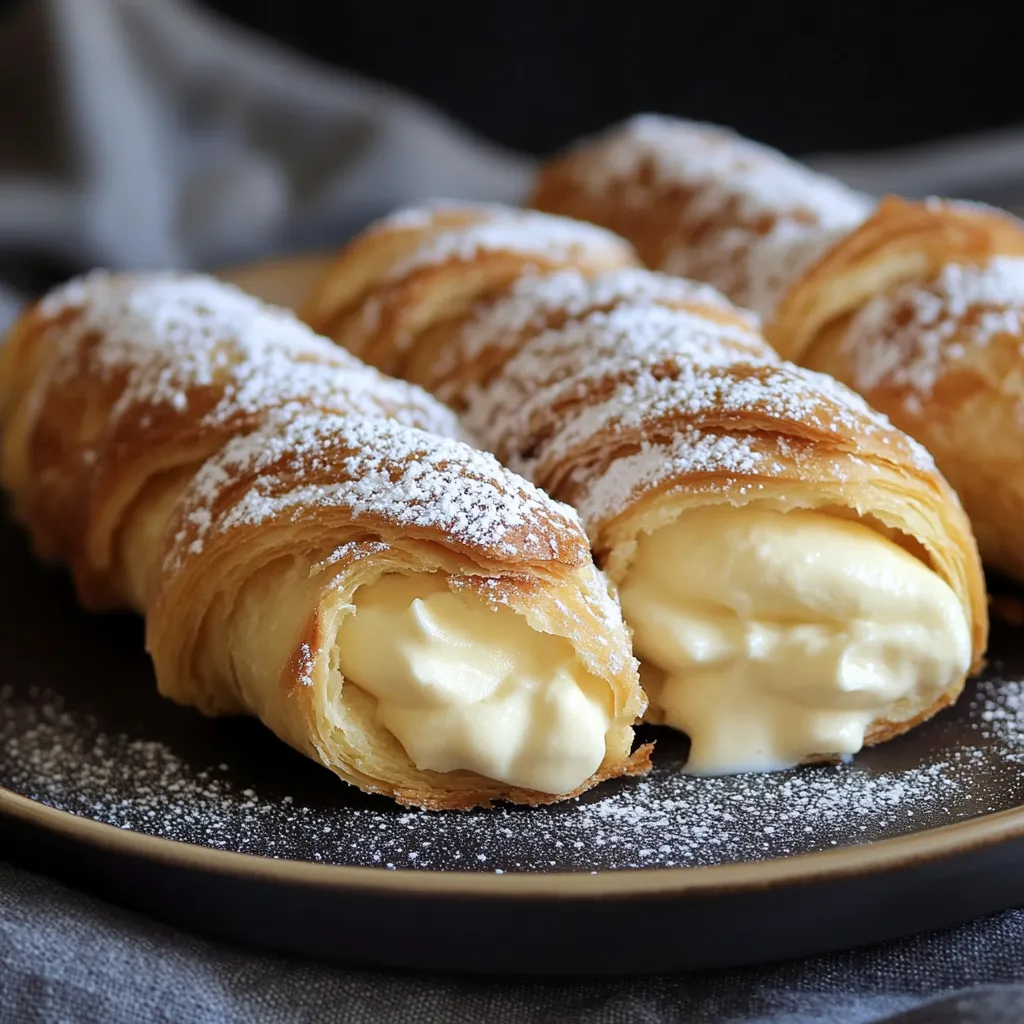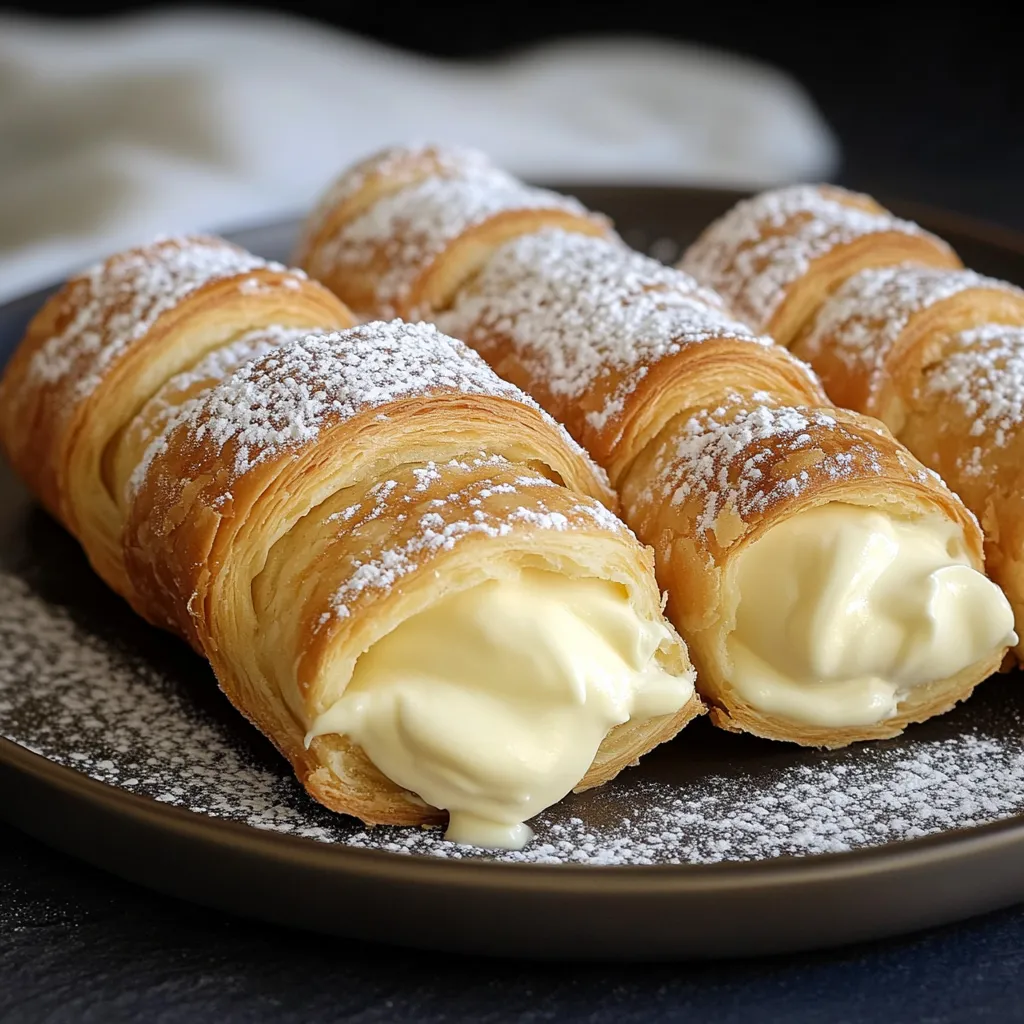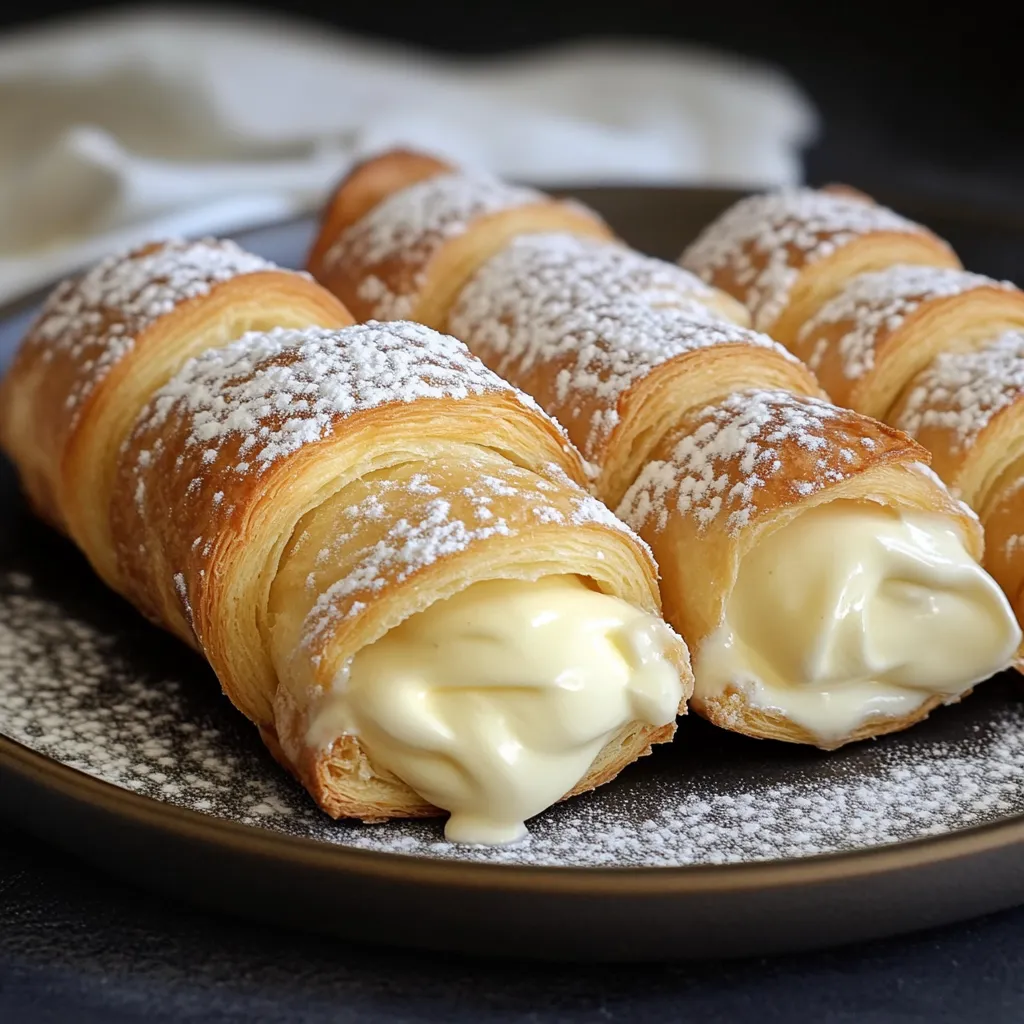 Save
Save
Buttery puff pastry horns stuffed with smooth custard make these Italian cannoncini a true kitchen triumph. These cone-shaped treats blend flaky, crisp exteriors with velvety cream fillings in perfect harmony. Each bite offers that magical mix of textures that Italian bakers have mastered—the delicate, airy pastry giving way to rich, silky custard that's made this dessert a worldwide favorite.
My first bite of these cream-filled delights happened at a tiny bakery tucked away in Florence. When I got back home, I couldn't stop thinking about them. I tried making them five or six times until I finally got the taste just right—that same flavor that took me straight back to Italy. Now my family begs for these whenever we celebrate anything.
Key Ingredients Breakdown
- Egg Yolks: These yellow powerhouses bring richness and smoothness to your custard. Let them sit out before using so they mix better with everything else. They've got natural binding powers that help create that dreamy texture everyone loves.
- All-Purpose Flour: You don't need much, but this stuff works magic for perfect custard thickness. Always sift it to avoid any lumps in your smooth cream. When heated, the starch in flour swells up and helps thicken everything just right.
- Sugar: This does more than just sweeten—it helps your custard hold together and makes vanilla taste even better. Go with fine sugar since it melts quicker and won't leave any gritty bits in your cream.
- Vanilla Extract: This is what gives your custard its soul. Real extract beats the fake stuff every time. Try to find one with little dark specks in it—that means it's got real vanilla bean in there.
- Whole Milk: This forms the heart of your custard. Don't swap it for low-fat versions—you need that fat for proper creaminess. Heat it slowly or you'll burn it and ruin the whole thing.
- Puff Pastry: This makes or breaks your cannoncini. Get the good stuff with real butter if you can. Those countless thin layers give you that amazing light crunch that works so well with the filling.
- Egg Wash: This is your secret for getting that pretty golden color and shine. Just beat a whole egg with a bit of water and you're good to go.
- Powdered Sugar: The finishing touch that makes everything look prettier and adds a touch of sweetness. It melts right into the warm pastry surface.
Making Flawless Cannoncini
- Making The Custard:
- Warm up the milk in a pot but don't let it boil. In another bowl, mix your egg yolks, sugar, vanilla, and flour until it looks smooth and a bit lighter than when you started. This mixing puts air in there which makes your custard lighter. Slowly pour your warm milk into the egg mix while you keep stirring. This gentle approach stops your eggs from cooking too fast and turning lumpy. Pour it all back into your pot and cook it on medium heat. Keep stirring with a wooden spoon until it gets thick like pudding. You'll know it's ready when you can run your finger through the coating on the back of your spoon and leave a clear path. Put it in a bowl, cover it with plastic wrap touching the surface so no skin forms, and stick it in the fridge for at least an hour to set up properly.
- Shaping The Pastry:
- Get your oven hot at 400°F (200°C). Instead of using flour, cover your counter with sugar. This sugar will turn all caramelized and yummy when your pastries bake. Roll your puff pastry into a 9×12 inch rectangle, pressing it into the sugar as you go. Cut it into twelve strips about an inch wide using a sharp knife. Take each strip and wrap it around a metal horn mold, starting at the tip and letting each wrap overlap the last one a bit. Make sure the sugary side faces out. Put them on a baking sheet with parchment paper, leaving room between them since they'll grow in the oven.
- Oven Time:
- Mix one egg with a spoonful of water until they're completely combined. Brush this mixture over your pastry horns, but don't get too much in one spot or let it drip onto the tray. This coating helps them turn that perfect golden color and gives them a nice shine. Bake them for about 15-20 minutes until they're deep gold and you can see all those puffy layers. Watch them closely near the end—they can burn fast! Take them out and let them cool a little before gently twisting to get the metal forms out.
- Putting It All Together:
- Make sure both your pastry horns and custard are totally cool before you start filling. Put your custard in a piping bag with a star tip. Stick the tip deep into each horn and squeeze, filling from inside out until cream shows at both ends. Right before you serve them, dust them with powdered sugar—if you do it too early, the sugar will just melt into the cream.
 Save
Save
I've found I really like adding some lemon zest to my custard filling. That little bit of citrus cuts through the richness and wakes up the whole dessert. My grandma always told me the real trick to perfect cannoncini was taking your time—never rush when you're cooking the custard if you want that super smooth texture that makes these pastries so special.
Ways To Present
These fancy treats taste even better with the right company. Try them alongside fresh berries mixed with a touch of sugar and lemon for a pretty color pop and fruity balance to the rich pastry. When you want something extra indulgent, drizzle some good chocolate sauce on the plate before adding your cannoncini. These pastries were made for coffee—serve with espresso or cappuccino for a true Italian coffee shop feel. For big events, arrange them on a tiered stand with some fresh flowers and other small desserts to make a stunning display that'll wow your guests.
Flavor Twists To Try
The basic vanilla custard works great, but don't be afraid to play around. Soak some coffee beans in your milk before making custard for a grown-up coffee-flavored filling. Chocolate fans can mix in two spoonfuls of cocoa powder to the custard before cooking. For something different, try mixing finely chopped pistachios into your custard for crunch and nutty flavor. If you like citrus, swap the vanilla for orange blossom water and throw in some fresh orange zest. You can even change up the pastry by mixing cinnamon with the sugar coating before you roll it out.
Keeping Them Fresh
Empty pastry horns stay crispy when kept in a sealed container at room temp for up to two days. Your custard filling will last in the fridge for up to three days if you keep it covered with plastic wrap touching its surface. For the best experience, don't fill your cannoncini until shortly before you plan to eat them. If you must fill them ahead, don't keep them in the fridge longer than four hours or your crispy shells will turn soggy from the cream. When you're ready to serve pre-filled cannoncini, let them sit out for 15 minutes and add a fresh dusting of powdered sugar.
I've learned that getting the temperatures right really matters when making cannoncini. Your pastry needs to stay cold until it hits the oven, while the custard wants gentle, patient heat to develop its perfect silky feel. These Italian cream horns show off everything great about baking—simple ingredients transformed through technique into something amazing. They might look complicated at first, but once you master them, you'll feel so proud, and they'll create wonderful moments when shared with people you care about.
 Save
Save
Recipe FAQs
- → Is it okay to prepare the cream early?
- For sure, you can make the cream up to two days ahead. Stash it in the fridge in a sealed container with plastic directly on the surface, keeping it smooth and fresh.
- → What if I don't own pastry molds?
- No molds? No problem! Just mold some aluminum foil around a spoon handle, slide it off carefully, and use those as your DIY pastry molds.
- → Can I freeze them before serving?
- Freeze unfilled shells only. Once thawed, make them crisp in the oven, then fill with fresh cream. Avoid freezing filled ones; the custard gets watery.
- → Why didn’t my pastry rise well?
- The pastry might have gotten too warm. Keep it chilled, and if it softens too much as you work, let it cool in the fridge for 15–20 minutes before baking.
- → How long will these stay good?
- Enjoy them best within 24 hours after filling. Leftovers can sit in the fridge, but know that the pastry softens over time from the custard inside.
